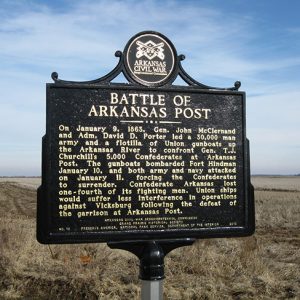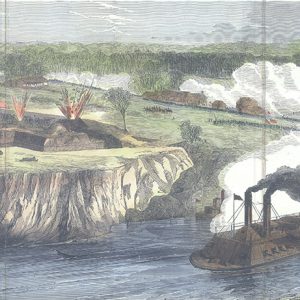calsfoundation@cals.org
Fort Hindman
Located on the Arkansas River near the site of Arkansas Post, Fort Hindman served as an important Confederate defensive fortification during the Civil War. Captured by a combined force of Federal troops and the Union navy, the fort was destroyed in 1863, and the site was eventually claimed by the river.
On September 28, 1862, Major General Theophilus Holmes ordered the construction of fortifications along the Arkansas and White rivers. The construction of these fortifications was in direct response to Federal movements on the Mississippi River and followed a Union fleet attacking a Confederate post at St. Charles (Arkansas County), located on the White River. Located about twenty-five miles above the mouth of the Arkansas River, Arkansas Post was selected as the site of one of these forts. The location selected placed the fort in a horseshoe bend that afforded the garrison a view of approximately one mile both upstream and downstream.
Lieutenant John Dunnington of the Confederate navy was placed in charge of the construction of the fort along with two civilian engineers, a company of sappers (combat engineers), impressed slaves, and Confederate troops providing additional labor. Work progressed quickly, and the main fortification was completed by late November. It was named for Major General Thomas C. Hindman, commander of the District of Arkansas and former commander of the Department of the Trans-Mississippi.
The fort was a square, with exterior parapets 100 yards in length. Surrounding the fort was a ditch, twenty feet wide and eight feet deep. A firing step for infantry ran the length of the interior walls, and two casemates were constructed in the fort, each housing a single gun. Three heavy guns defended the fort: two nine-inch columbiads and one eight-inch. The guns previously served on the CSS Pontchartrain, and thirty-five Confederate sailors, along with Dunnington, were transferred to the fort to operate the weapons. Four ten-pound Parrott rifles and four six-pound guns were also placed in the fort, resting on artillery platforms. Inside the fort perimeter were a well, two magazines, and three buildings. Outside of the fort, a line of trenches ran to the west for about 720 yards before it terminated at Post Bayou. Additional rifle pits were located to the northeast. A hospital opened in the nearby town of Arkansas Post, and winter quarters began to be constructed several hundred yards to the north of the fort.
In December, the garrison at the fort was increased, bringing the total number of units to three brigades of mixed infantry, cavalry, and dismounted cavalry, with some artillery support, for a total of 5,000 men. The troops hailed from Arkansas, Texas, and Louisiana and were joined by a new commander, Brigadier General Thomas James Churchill. A failed Union attempt to take the fort in late November and early December emboldened the Confederates, who captured the Federal transport Blue Wing the last week of December. The ship, which was carrying munitions and coal, was brought to the post and unloaded. This action brought the fort back to the attention of Union commanders, and a force under the command of Major General John McClernand embarked on a mission to neutralize Fort Hindman.
With a combined force of troops and naval vessels, the Federals arrived at a plantation near the fort on January 9, 1863, and launched a bombardment from the ironclads and other ships in the fleet the next afternoon. On January 11, McClernand launched a land attack after the navy had silenced all of the guns in the fort. Late that afternoon, the Confederates surrendered.
Almost 5,000 men were captured and shipped to prison camps in the north. The Federal force destroyed as much of the fort as possible before departing the area. The area saw no fighting for the remainder of the war.
The remains of Fort Hindman continued to stand alongside the Arkansas River for several years, but the entire structure had been taken by changes in the course of the stream by 1880. Some of the trenches still exist, but little else remains of the fort. The site is managed by Arkansas Post National Memorial.
For additional information:
Arkansas Post National Memorial. http://www.nps.gov/arpo/index.htm (accessed November 24, 2020).
Bearss, Edwin. “The Battle of the Post of Arkansas.” Arkansas Historical Quarterly 18 (Autumn 1959): 237–279.
Christ, Mark K. Civil War Arkansas, 1863: The Battle for a State. Norman: University of Oklahoma Press, 2010.
Coleman, Roger. The Arkansas Post Story: Arkansas Post National Memorial. Professional Papers No. 12. Santa Fe, NM: Southwest Cultural Resources Center, 1987.
The War of the Rebellion: A Compilation of the Official Records of the Union and Confederate Armies. Series 1, Vol. 17, Part I. Washington DC: Government Printing Office, 1889.
David Sesser
Henderson State University
 Civil War through Reconstruction, 1861 through 1874
Civil War through Reconstruction, 1861 through 1874 Military
Military USS Fort Hindman
USS Fort Hindman ACWSC Logo
ACWSC Logo  Battle of Arkansas Post
Battle of Arkansas Post  Battle of Arkansas Post
Battle of Arkansas Post  Battle of Arkansas Post Marker
Battle of Arkansas Post Marker  Fort Hindman Attack
Fort Hindman Attack 




Comments
No comments on this entry yet.